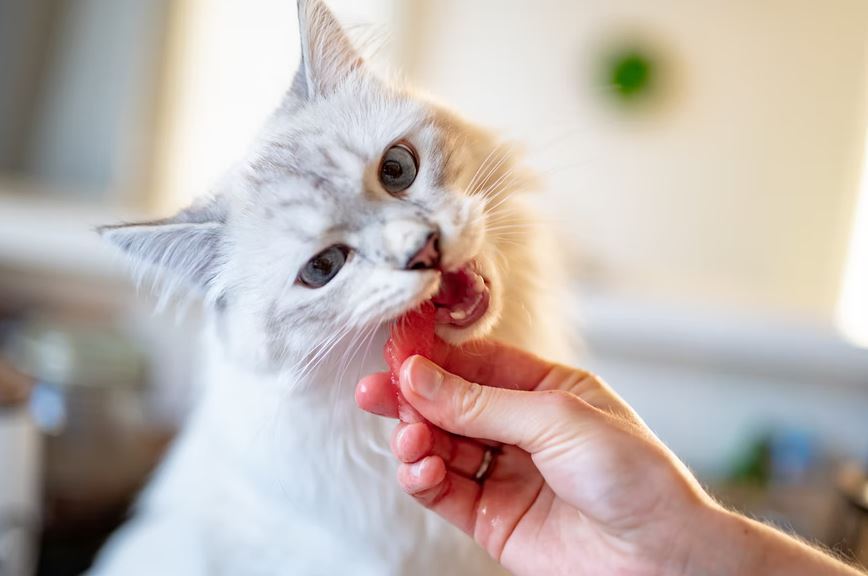Many of us keep our own reserve of our best-loved snacks in the fridge, cupboard, or pantry. If you’re a cat guardian, chances are you do the same for your beloved feline, hoarding them a stockpile of their preferred treats. But do you really need to indulge your cat with treats? How often should you give them treats? Are there benefits to it – or is it just merely passing our habits of eating snacks and some of its drawbacks?
How Often to Give Your Cat Treats
Truth to be told, your cats don’t need treats. What she actually requires is a well-balanced diet composed of good quality cat food that suits her age, size, and weight. If you are not sure what foods and how much your cat needs, talk to your veterinarian for the best recommendations.
Yet, that doesn’t mean you shouldn’t give your cat a few tasty treats. A good rule of thumb is that treats must only compose 5-10% of their daily calorie allowance. Like how much we’d like to live on chocolate, ice cream, or chips alone, we can’t.
It’s the same with your cat, as treats lack the nutrients traditional cat food provides. Having a bulk of her diet in treats simply won’t make her healthy. As the word suggests, a treat should be given only for special occasions or small moments for pleasure or as a complement or reward.
How to Use Cat Treats
Rather than giving your cat treats randomly, it’s best to put them to good use. Here are many ways you can do so:
Cat Training
Dogs are more obedient and easy to motivate than cats, making pooches more trainable. Still, you can train your stubborn cat and treats can be a huge boost to that. You can reward a treat to any good behavior or a newly learnt task. That way, your cat can associate the action with a positive experience, making her more likely to repeat and eventually learn the command.
Establishing Bond with Your Cat
Is your cat aloof? Well, cats are actually not obligate social animals. They can either take or leave any social interaction. Yet, it doesn’t mean your cat doesn’t love you. In fact, felines can feel strong affection for their guardians and companions. Sometimes, all you need to do is to establish and strengthen that bond.
Like in training, use yummy treats to create positive associations. Give your cat a treat, and accompany it with gentle tickling under her skin, strong her back, or petting her head. Your cat will feel more comfortable with and hang around. Soon, she’ll show her love in her own unique ways, from kneading, purring, or following you from room to room.
Getting Nutritional and medicinal benefits
You might be surprised, but some treats are specifically made to provide certain nutritional and medicinal benefits. For instance, there are treats intended for helping reduce hairballs or treats with chondroitin and glucosamine to facilitate joint relief. Meanwhile, dental treats are designed to supplement your cat’s dental maintenance. Yet, again, treats must never replace regular care.
Developing a Routine
Using treats is also an excellent way to help your cat with a routine. Felines are creatures of habit. They love to do things at regular hours, which makes them feel safer and more confident. For example, do you want to set a specific time for any task? You can provide treats at the start of your preferred hour to help reinforce a pattern. Do it consistently and your cat will develop that specific routine every day. You can do this on other activities you deem important in your household timetable.
Hiding Medications
Cats are picky eaters. So, imagine how much easier it is for them to turn their heads away from medications. If your cat is ill but needs to take some pills, you can conceal it in a treat or reward after she has taken any to make the process easier for you and your cat the next time around.
Encouraging playtime
Your cat needs to stay active to keep her overall wellness in check. Experts say that cats need an average of 30 minutes of moderate exercise daily. This can take in a form of playtime. However, not all cats may have enough motivation to play. A quick and easy way to remedy that is by providing her with treats during the activity. For instance, you can place a few treats in a food puzzle or activity. Cats love to hunt and will surely be encouraged to play and get these tasty treasures.
How many cat treats is too much?
As mentioned, treats, whether it’s catnip, cooked meat, fish, milk, dry treats, biscuit treats, lick treats, or homemade ones, should only make up 5 to 10% of your cat’s recommended daily calorie intake. Going over that can result in a variety of issues, such as:
Obesity
Various reports show that around 40 to 50% of felines are affected by obesity. Overfeeding combined with lack of exercise is usually the biggest culprit of unnecessary weight gain. Part of the problem is that many cat owners tend to provide extra treats to their pets as a way of expressing love, not knowing that it can contribute to obesity. Remember, being overweight may expose a cat to risks of heart diseases, diabetes, joint pain, and arthritis.
Lack of Nutrition
Most cat treats, unlike commercially prepared cat foods, are unbalanced. That means they lack the vitamins and minerals to make your cat healthy. Providing your cat with too many treats won’t do her any good as treats have very little nutritional value.
Addiction
Though it may seem crazy, some cats will refuse to eat their normal cat food meal, and instead depend on treats. Sometimes, it’s hard to resist when cats ask for treats, causing some owners to give in. It develops into a pattern, which cats adapt to so the cycle continues. Make sure to stop giving treats right away when that happens.
Final Words
There’s nothing wrong with giving your cat treats as long as you do it in moderation and for good reasons. Be mindful that treats should only serve as complements and must never replace your cat’s main meals. Also, don’t forget that regular visits to the veterinarian will also help ensure that your cat is always happy and healthy. Happy treating!

